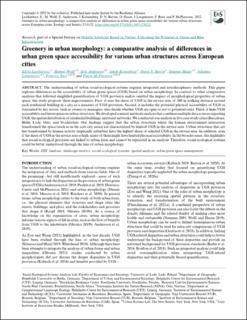Greenery in urban morphology: a comparative analysis of differences in urban green space accessibility for various urban structures across European cities
Łaszkiewicz, Edyta; Wolff, Manuel; Andersson, Erik; Kronenberg, Jakub; Barton, David Nicholas; Haase, Dagmar; Langemeyer, Johannes; Baró, Francesc; McPhearson, Timon
Peer reviewed, Journal article
Published version

Åpne
Permanent lenke
https://hdl.handle.net/11250/3024894Utgivelsesdato
2022Metadata
Vis full innførselSamlinger
- Publikasjoner fra CRIStin - NINA [2364]
- Scientific publications [1392]
Originalversjon
10.5751/ES-13453-270322Sammendrag
The understanding of urban social-ecological systems requires integrated and interdisciplinary methods. This paper explores differences in the accessibility of urban green spaces (UGS) based on urban morphology. In contrast to other comparative analyses that followed simplified quantification of UGS provision and/or omitted the impact of morphological properties of urban space, this study proposes three improvements. First, it uses the share of UGS in the service area of 300 m walking distance around each residential building in a city as a measure of UGS provision. Second, it includes the potential physical accessibility of UGS as warranted by key actors, such as owners or managers, who decide whether UGS are open or not to potential users. Third, it links UGS accessibility and heterogeneous urban structures. We developed a mixed-methods analysis that combines multiple data sources regarding UGS, the spatial distribution of residential buildings, and street networks. We conducted our analysis in five case-study cities (Barcelona, Halle, Lodz, Oslo, and Stockholm). Our findings suggest that the urban structures where the human–environment interaction transformed the space (such as in the core city areas) are characterized by limited UGS in the service area. Urban structures that are less transformed by human activity (especially suburbia) have the highest share of selected UGS in the service area. In addition, even if the share of UGS in the service area is high, many of them might have limited physical accessibility. In the broader sense, this highlights that social-ecological processes are linked to urban form and cannot be separated in an analysis. Therefore, social-ecological systems could be better understood through the lens of urban morphology. GIS; land use; landscape metrics; social-ecological systems; spatial analysis; urban green space management
